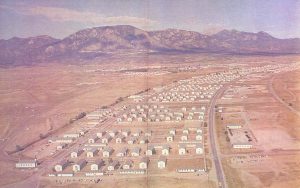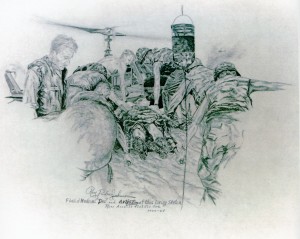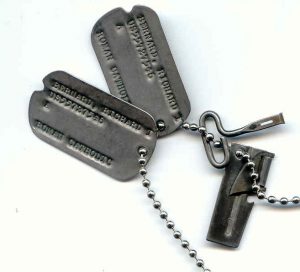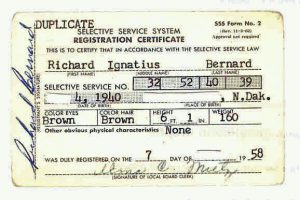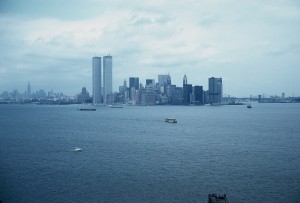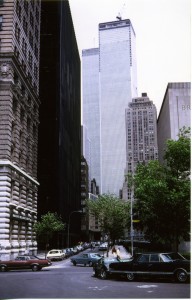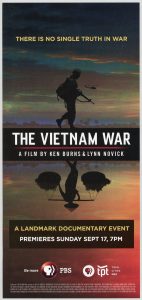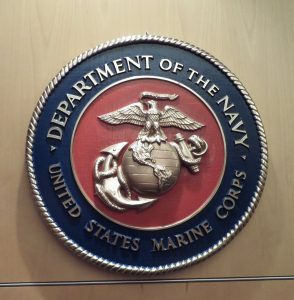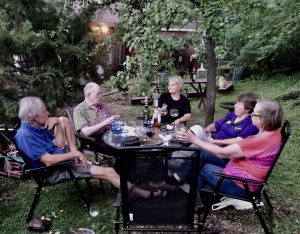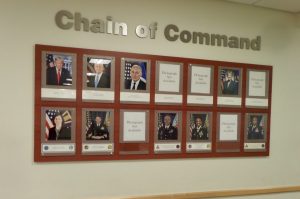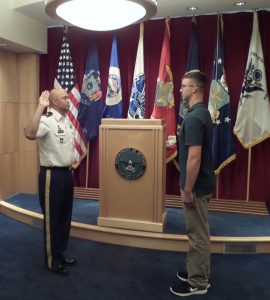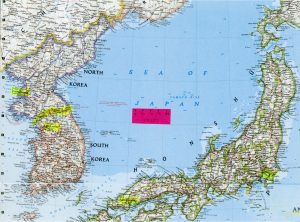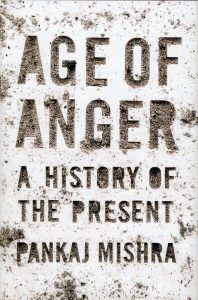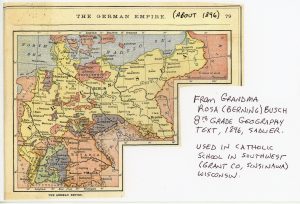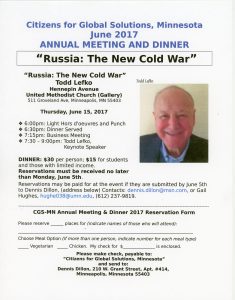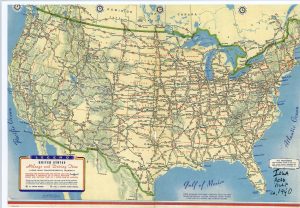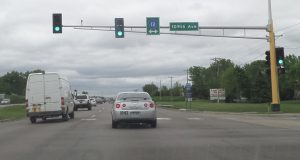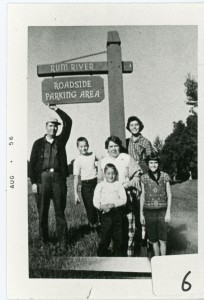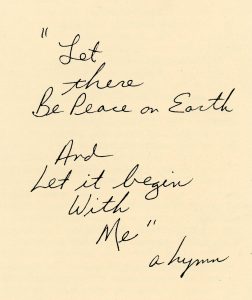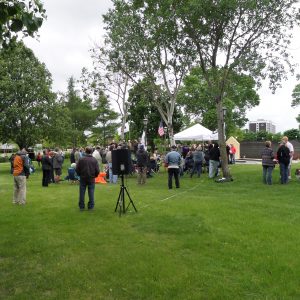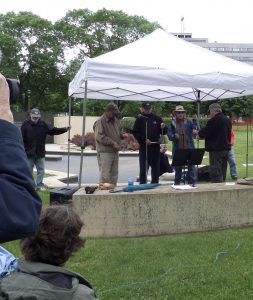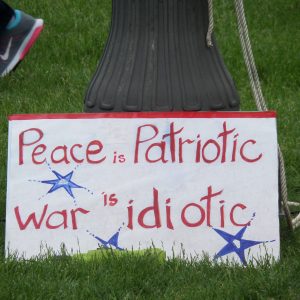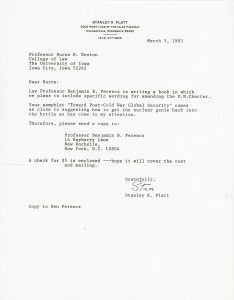June 29, 2017: Recommended by a reader: The Heart of Everything That Is: The Untold Story of Chief Red Cloud, an American Legend
*
POSTNOTE 5:20 p.m. May 31 – A decision was made about the Scaffold today. See comments section below.
POSTNOTE 8:30 a.m. June 1 – This seems an appropriate place/time for a general timeline of historical events impacting on this conversation: FAHF Timeline 001. This two-page document was prepared by the French-American Heritage Foundation in 2016 as a beginning sketch of relationships in Minnesota and surrounding areas.
UPDATE June 2 here
*
ORIGINAL POST May 31
If you are around the twin cities and follow the news at all, you’ve heard the controversy about the new proposed exhibit at the refurbished Walker Art Center Sculpture Garden. The tentative decision has been made to remove the Scaffold, and today is the official meeting about it. The issue is of such concern to me that I hand-delivered a letter plus photos to the Executive Director of Walker Center Tuesday afternoon. There has been, and will continue to be, news in Minneapolis Star Tribune, if you wish.
Here’s a photo I took of the sculpture at issue on Sunday:
(click to enlarge)
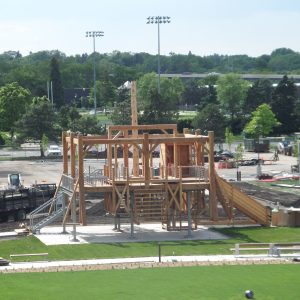
The Scaffold, from Lyndale Avenue, May 28, 2017.
To begin, here are the positions of the sculptor and the Walker Art Center, as found at the sculptors website (click on the tab “NEWS”). This perspective, probably not seen thus far, helps provide relevant background. In part, from the artist statement: “Scaffold opens the difficult histories of the racial dimension of the criminal justice system in the United States, ranging from lynchings to mass incarceration to capital punishment. In bringing these troubled and complex histories of national importance to the fore, it was my intention not to cause pain or suffering, but to speak against the continued marginalization of these stories and peoples, and to build awareness around their significance.”
Before I visited the above website, I had delivered the following personal letter, along with photos, to Walker Art Center. The letter is presented as sent, with slight additions in brackets to help give additional context. I’d be interested in other perspectives, if you wish.
My letter to Walker Executive Director Olga Viso, May 30, 2017:
“We are members of Basilica of St. Mary. Each time we drive home we pass by the Sculpture Garden heading south on Lyndale. So it was, Sunday, about 11 a.m. We saw the “Scaffold”, and then read about the controversy in the STrib. Later that afternoon I went back for a closer look.
The Scaffold should stay. Its message is powerful and it is needed. This is a complex issue. In my opinion, both the Walker and the advocates for removal are making a serious mistake in taking down this powerful work. Everyone will be the losers.
To be clear, I’ve long had an interest in the disgrace of December, 1862, in Mankato, and the events which preceded it, and the long history of running the Native Americans off their land, however that has been justified. The existence of the Scaffold is essential to an essential conversation. Yes, it is stark, as it should be. I am grateful that it was contemplated, completed and installed, and yes, for the controversy which brought it to my attention.
September 21, 1997, I traveled to Mankato for the solemn dedication of the Memorial there, indeed I visited briefly with the Sculptor.
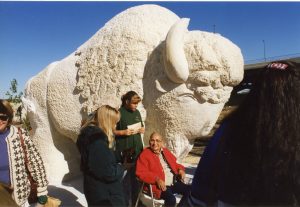
At the Mankato dedication, September 21, 1997.
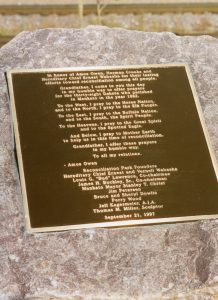
The Dedication Plaque at Mankato 9/21/1997
Perhaps the Mankato executions drew me because one of my earliest Minnesota ancestors, Samuel Collette of Centerville, was a private in the First Regiment of Mounted Rangers, General Sibley’s command, Oct. 6, 1862 – Nov. 28, 1863, and thus quite possibly he was at Mankato at the time of the executions. Samuel came to Minnesota in 1857, from Quebec. Depending on one’s particular point of view, in this instance, he was good or evil. For a year he was part of the militia which drove the natives west of the Missouri River and on to Reservations. [The official narrative of the Rangers, written about 1890: Mn Mtd Rangers 1862-63001].
Both my paternal and maternal ancestors have benefited from white settlement taking native lands in northeast and south central North Dakota. My mothers parents had been in North Dakota four years when the monument was set at the site of Whitestone Hill massacre, about 30 miles from their new farm. As you likely know, the Whitestone monument is to the dead soldiers who had been part of the unit which massacred the Natives encamped there for the annual buffalo hunt. Years later a simple symbol – an unlabeled boulder down the hill from the monument – was placed remembering the slain Native Americans. I’ve been there many times [most recently a year ago]. More on the deadly encounter here. [Longer articles can be read at Whitestone Hill 1863001, and Whitestone 1863 at 1976002]
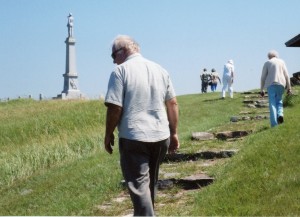
Whitestone Hill ND July, 2005
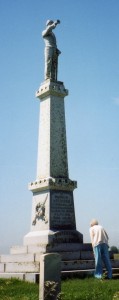
Whitestone ND Monument July 2005
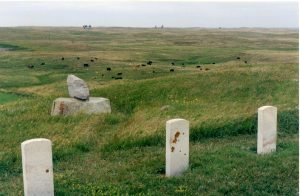
At Whitestone Hill Aug 1994. Below soldier graves is a plain stone monument to the Indian victims in 1863
Succinctly, I’ve thought a great deal about the Hanging and similar atrocities in our past, and in the world itself…the focus of the Scaffold.
Were I in charge, I’d suggest a timeout of weeks, months or years to talk about what this all means.
Removing the Scaffold, will not destroy it or put it in hiding – I took 19 photos of my own yesterday; removal will do nothing to improve understanding or relationships or anything else.
Looking at the Scaffold for the first time, Sunday, from the other side of the fence and the protest banners, I thought it would present an excellent focal point for better public understanding of our often inglorious history as a people.
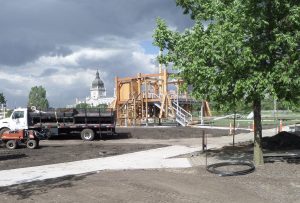
The Scaffold, with the Basilica of St. Mary in the background, May 28, 2017.
Put the sculpture in its own “prison” if you wish, surrounded even by concertina wire, but do not remove it. Let us see it, with a large plaque explaining what it is; why it was envisioned and commissioned. Let us talk about its meaning, publicly.
There are analogies, though every such event/place/circumstance is unique.
In 2000, we were with a Pilgrimage of Christians and Jews from Basilica of St. Mary and Temple Israel to Auschwitz-Birkenau and other holocaust sites.
At Birkenau the horrid railroad tracks, examples of the awful barracks, even the remains of the hideous ovens, are kept as permanent reminders of the horrors that happened there.

May 4, 2000. Approaching the entrance to Birkenau death camp, Poland. Photo by Dick Bernard
I have been to the Holocaust Museum in Washington D.C. several times. The memories displayed are not abstract. There, you are confronted with the reality of the horror.
I am only a citizen….”
Others at that meeting today in Minneapolis will move towards a decision on what to do. My hope is that the Scaffold remains and becomes a point for us to look at ourselves, reflectively, and work towards a better future.
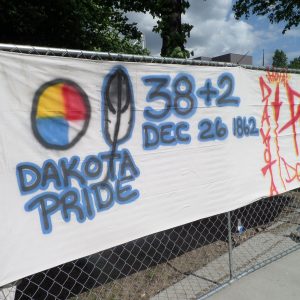
May 28, 2017. Walker Art Center Sculpture Garden Site.
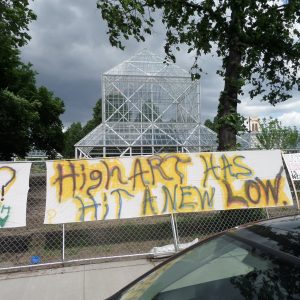
One of the protest signs at the site, May 28, 2017
Your opinion? My e-mail dick_bernardATmsnDOTcom if you want to share thoughts with me, and with others through this post.
COMMENTS:
1. From Norm: I’m with you Dick. There aren’t enough such things to remind us of our past indiscretions.
2. from Virgil: Your position is well explained. I think you know me well enough that I would be an ally to not forgetting history as it has been lived with its particular circumstances for communities and individuals across the globe.
Thank you for your very clear explanation and for creating a platform for facing issues which should influence our thoughts about the place others should have in a world where dominant stories represent positions of a strength that should be tempered through a call such as you are putting forth.
3. from Jerry: Thanks, Dick, for your response to the new art at Walker Art Museum. I agree with you that the scaffold should remain and reasons for it given. We keep trying to hide the history of our relationship with the Native Americans and so much of it is very painful. I need to get over to see the art piece myself.
4. from Jeff: I agree with you on this.
The recent art display on lynching in America at the Museum of Modern Art in St Paul was excellent. Open wounds need to see sunlight to heal.
I think part of the issue is that native americans were not consulted on the piece. They should have had a seat at the Table.
5. from Bill: Dick, as an 8 year old child I had a very personal experience with this 1863 Indian uprising when my neighbors took me to the 75th anniversary of the uprising in Mankato in 1938. I approached a very elderly Indian man and made a comment to him about how bad the Indians were and he responded to me “Little boy, remember there are two sides to every story!” I have never forgotten that wisdom when ever there were sides being proposed in an argument.
As an adult I have read about the circumstances that led to the Indian uprising and have come to the conclusion that the Indians had been betrayed by the White politicians of the day in their promising that land along the Minnesota River would be set aside for Indian settlements only to have much of these lands taken over by the flood of European immigrants occurring about that time. Just one more broken promises of the White Man to the Indians.
6. from Greg: I must confess to being a contributor to [the Scaffold] controversy, albeit unintentionally. I remember attending the Lunch with [my City Councilperson] at which Olga Viso, the Walker Executive Director, described the artwork being added to the garden.
For some sad reason this controversy potential escaped my thought process. Thus, I failed to speak privately with her to politely express my strong opinion the Walker was making a major mistake in proceeding with the installation in the manner they had chosen, apparently without first meeting and speaking with members of the Native American community.
I agree that The Scaffold should ultimately remain. I also understand the reaction of the people who oppose The Scaffold, but this reaction does not seem to be acknowledging the valuable educational value of this art work, and that the Native American community will benefit from such educational value, as will we all.
7. from Jermitt: Thank you once again for your thoughtful and inspiring commentary. As a Nation we continue to fail in our commitments to the Native American Communities. And we continue to cover up our faults. Only through lessons from the past can we prevent similar atrocities in the future. Thank you, my friend.
8. from Janice: Powerful blog. Thank you for forwarding. You articulated my views—although with quite a personal history to back it up. I think it can be a powerful and important part of our city. I hope they can reconcile all the parties. Already, look at all of us who now know of this history, who were ignorant before (me included!)
9. from Johnathan: Beautifully written and expressed – US owns its share of national shame. Sunlight heals wounds. Native American voices must express their perspective on The Scadfold. Asking forgiveness is a means of educating future generations to the worst and best of the human condition. Thank you for sharing a great example of balanced and mindful view of facts…and the realities continued to be faced by Native Americans – and all human beings.
10. from Catherine: I too would like to see the sculpture remain, but I would stipulate that it be under the curatorship of the artist along with the local tribes of wherever it’s being displayed. It’s their history and they have never had proper control over it in the history books or the art world. The scaffold itself is painful — that’s the point — but unless it’s exhibited as a teaching tool and a public apology, it could be downgraded easily by trivial popular culture. That has to be avoided. Years ago the Mpls Art Institute had a controversial show on the costumes of the Native Americans for a secret religious ritual. Out of respect they worked closely with the local native population and had the galleries blessed by one of their elders. Even so there were complaints but overall that gesture was appreciated. I think the Walker meant well but went about it wrong.
11. from Catherine, 4:43 p.m., 8 minutes after preceding: Looks like we’re all too late. It will be dismantled by the Dakota and burned at Fort Snelling. That will be impactful at the moment, but what will remain of the many lessons learned?
11A. from Dick: Thank you, Catherine. I heard the same news at 5:10 p.m. on the news. I’m glad I made the effort, and I think burning the symbol will not be as effective as it being used as a long-term learning tool. But…the decision is made, apparently.
12.from Florence: Recently the daughter-in-law of friends of ours had a painting displayed at an art gallery in NYC. The subject was of a 14-year old boy who had been mutilated and hung to die, accused of raping a white woman, in the 1940’s. Yes, he was black. There was a huge out-cry from the African American community and a demand that the painting be removed and destroyed for dishonoring them. I supported their sentiments in my heart, as I support the sentiments of the Native American community against the Scaffold sculpture. Both artists had good intentions, but failed to talk with people from the injured communities. Those injuries don’t go away with time. We need to “walk a mile in their shoes.” I understand that the Walker Art Center has reached an agreement with the Native American community to remove and burn the sculpture/playground. I’m grateful.
13. from Paul: Dick, I, too, have been pondering this “Scaffold” incident. However, I have a very different conclusion than you.
“The road to hell is paved with good intentions.”
You seem to argue that the sculpture, “Scaffold” has good intent. And I can agree it has spurred a meaningful and perhaps eventually productive discussion and long deserved public attention to the history of injustice represented by government conducted executions.
However, another view of the sculpture and its prominent display at the Walker Sculpture Garden is to see it as an example of cultural appropriation by a white artist and the white dominated Walker Art Center.
Mostly we see cultural appropriation when the dominant culture uses artistic or cultural characteristics from a minority race or nationality. Sometimes these are displayed in offensive ways such as a tomahawk or headdress used by a sports team. Other times they seem more benign such as using in a new way some hot sauce borrowed from Mexican style cooking. I think back to when white hippies wore afro hair styles – clearly cultural appropriation. When is it wrong? Sometimes it is obvious, sometimes it’s subtle and sometimes it is not so wrong at all.
But what about the “Scaffold” is cultural appropriation? The indigenous people and other groups who have suffered the long-term trauma of past aggressions against their ancestors have a primary claim of ownership to the use and remediation of that trauma in our white dominated culture. The artist and the Walker failed to recognize that claim. While attempting to stimulate the healing dialog that is so needed, they failed. The did not even realize that the people who most need to have the power over the remediation of their cultural trauma were being ignored in the creation and the installation of this sculpture. From their point of view, it is white domination all over again. Just another example of the white power players deciding what is good for them, what is the best way to confront their trauma, what is the best way to start the healing.
At the very least, the artist when he first conceived the sculpture a few years ago, owed to the descendants of the victims for whom he had so much sympathy the opportunity to be part of the creation of the sculpture and it’s presentation. The Walker Art Center likewise owed those same people a chance to know about the sculpture and weigh in on its merits and the way it should be displayed (or not displayed).
Good intentions do not excuse colossal blunders. There is a reason that quote at the start of my thoughts is famous.
Now it is time for the next steps to be taken in concert with the people who are the victimized cultures. The Walker, the artist, other institutions have this responsibility. They should provide opportunity for these steps. They are not the leaders in this. They should be the followers. They can apply their resources to the cause and help facilitate.
14. from Fred: A very thoughtful piece on a terribly complex subject. Your family and personal history makes you well qualified to consider the topic. I hadn’t considered the situation in Minneapolis in the light of the German decision to preserve evidence of the Holocaust. The Mankato scaffold and what it represents should be burned into the minds of Minnesotans and their fellow countrymen.
15. from Dick: Here is the official report of the result of the Mediation which will remove the art work. I will next comment after the structure is burned.
16. from Maryellen: Thank you for your very thoughtful and thought-provoking post on the controversy over the artwork called the scaffold. I read through all the comments with great interest.
The hangings of Dec. 26, 1862 are a haunting thing. It will take a lot more than this artwork to put these ghosts to rest.
This parallel lacks some exactness, but I bring it up for painful contrast: the scaffold is a form of execution and so was the cross. How would the early Christians have reacted to a ‘Cross’ created as a Roman work of art? Even with the intention of reminding everyone of its horror?
And yet, it is true that this ‘Scaffold’ may help, if only by reminding us all.
17. from Barbara: Dick – This is the best response I have heard. And I agree with you.
18. from a boyhood friend in ND: Interesting reading. There have been, and still are, some very horrible people living on this planet. We have talked about the book that I am trying to write about religion and the difficulty that I have on the issue of morality because of how hypocritical people are. I don’t know whether there is an afterlife with a heaven and hell, but if there is a hell, it will be full of folks like our founding fathers for what they did to the Native Americans and their enslavement of other humans. It would also be filled with the Europeans that were responsible for not only for the invasion of North America, but also the invasions of South America, Africa, Australia, and portions of Asia during their colonization movements, and what they did to the native populations.
One thing that I am always curious about is the big deal that the world makes about the German Holocaust. There were more Iranians killed in the Iranian Holocaust that we were partially responsible for, and far more Native Americans, and possibly Armenians at the hands of the Turks. So why do we all make a big deal just about the Jews. Hitler killed more Christians than Jews. Where are all the monuments and museums commemorating the deaths of all those Christians. And what about the hundreds of Christians that have been killed by Israel in Gaza? Over 400 in just the 2014 attack on the UN shelter in place facilities. Don’t they count? I could go on and on, but to no avail. It is unfortunate though that historically evil has generally trumped good.
And thanks for that bible atlas that you got from your friend. I will take good care of it and will return it if Joe wants it back. I got a kick out of your notion that this is a hand-me-down from a Jew to a Catholic, to a Muslim. I would have thought that you would know that to be a Jew, Christian, Muslim or any other of the Abrahamic sects, a prime requirement is that you worship the Earth God of Abraham, and that from our previous discussions of my book, I do not believe that the Earth God of Abraham exists, like so many others that are pursuing a set of beliefs that are more consistent with our current knowledge base. I am what is called a freelance monotheist. That was a term coined by a lady back in the 1990s, whose name I cannot remember. [Karen Armstrong]
19. from George: Being from MN and from a southern MN family I immediately related the scaffolding to Mankato. I see it as an item of horror not of art. Just as I see Kathy Griffin’s attention grabbing ploy to not be comic “art” but in poor taste, and definitely not a threat.
19A. Response from Dick: One of the most interesting comments so far has been from Maryellen (above): “It will take a lot more than this artwork to put these ghosts to rest.
This parallel lacks some exactness, but I bring it up for painful contrast: the scaffold is a form of execution and so was the cross. How would the early Christians have reacted to a ‘Cross’ created as a Roman work of art? Even with the intention of reminding everyone of its horror?”
I happen to be lifelong Catholic. I hadn’t thought of the cross piece before. There is hardly a more ubiquitous piece of art than the cross, including in church art. I’d guess Christians would consider the crucifixion on a cross as a “horror”, but nonetheless it seems acceptable as art. The question is a difficult one, I’ll say. Which makes the conversation even more important.
20. from Stacy: I liked your article and the perspective you have on this. It would be a shame to sweep this under the rug when it is such a opportunity for conversation and reflection.
21. from Sandy: Good and meaningful thoughts Dick! You certainly can speak with great knowledge on historical events and issues. thanks
22. from Rebecca: Because of your interest: Re: the Walker Art Center sculpture, I want to recommend to you the book An Indigenous People’s History of the United States, in paperback this year from Beacon Pr. It won the 2015 American book award. After reading this book last month, I contacted the author, a now 77 year old white/Indian woman scholar of American history who lives in California and is emeritus from one of the California universities. I contacted her just before the Walker art museum scandal had happened. I have invited her to come to the Twin Cities to speak and I will hopefully have an announcement about it at the MAP delegate meeting June 13th.
22A. Response from Dick: Thank you, Rebecca. Re “Because of your interest”, I’d like to share a few thoughts about what brought me to this particular place in my own history awareness and position on the sculpture issue. I’m North Dakotan, living there through college (1940-61). We lived, and thus I grew up, in a succession of tiny towns throughout the state. Basically, I’d say, the towns were Catholic; or Lutheran; there were Germans from Russia (mostly), and Scandinavians. That was our notion of “ethnic diversity”. This was back in the days when Catholics and Protestants had little to do with each other, to the point of outright hostility. There were others: Jews, Moslems, but they were rare and very unusual. It was not an enlightened time.
My mother grew up on a farm, which became very much like my “hometown”, as it was a consistent place in my life. My Dad grew up in a town of a few thousand, and his Dad was chief engineer in a flour mill.
I have said publicly as far back as the 1980s that “Indians” to us were about the same as “Negroes” in the south, even less fairly treated. Indeed, the situation for the Native Americans was probably worse, as they were on Reservations. My earliest memories, experienced, not spoken, were between 1945 and 1951 when, on occasion, we drove through the Ft. Totten Reservation near Devils Lake ND. I say “through”, it may have been beside – I don’t know for sure. What I am sure of is the sense I had as a kid that this was where the Indians lived, and it wasn’t a place you’d want your car to break down.
A few years later we lived a few miles west of Wahpeton ND, and I attended a tiny rural school and I was on the high school basketball team. At least twice we played basketball against the “Wahpeton Indian School” team out at the School of Science gymnasium. I remember the “Indian” ball players as very quick. I think that this was the same school, at about the same time, that author Louise Erdrich‘s father was superintendent. My Dad was school superintendent then at our tiny school. Both times we played on the Indian Schools court. Again, there was nothing spoken. The Indians were in their place, and it wasn’t with the rest of us.
Until the air bases and missile facilities of the late 1950s, there were few if any Negroes in ND.
I read somebodies memories of growing up in northeast North Dakota in the 1880s, and she remembered her French-Canadian mothers admonishment to the children: “Don’t trust the Indians or the Norwegians”!
I don’t have any Native-American ancestry – I’m half French-Canadian (Dad) and German (Mom) but I know of relatives of my French-Canadian grandparents generation who had strong native American ancestry. It is not at all unknown to me.
I first took a very active interest in Native Issues perhaps in the 1980s; in Whitestone Hill in the early 1990s. I am guessing the 1990s was the first time I knew of Whitestone (since it is remote – you need to be going there to really know it exists), and I’m also guessing it was a trip from the rural ND farm the 35 or so miles to see it. It is an impactful place, remote, alone, in its way beautiful. Rarely have I been there with any other visitors on the grounds. If one wishes an opportunity to meditate, Whitestone is a good choice.
My intention is to write more about this issue as time goes on, probably after the lumber is burned.
For certain, feel free to pass this along to the author you mentioned.
Thank you again.
22B. POSTNOTE, DICK June 9, 2017 The Scaffold has been disappeared from the news, replaced in today’s Minneapolis Star Tribune by a long piece in the Variety Section, “Something to crow about”. Where the Scaffold was would have been the first sculpture seen as visitors entered at the “New Entry. It has been disappeared.
The culminating event, the burning of the pieces of the Scaffold, has been postponed.
Personally, I think the apparent leadership of the Native American community and its allies missed a major opportunity for dialogue and reconciliation, and possibly they recognize this now, and too late. The Walker doesn’t distinguish itself either. One can only imagine the behind the curtain discussions, and debate, within both camps.
I may wander down to see the new Garden June 10. At some later date, when/if it is decided to burn the pieces of the scaffold, in one ceremony or in many, I will try to cover that story as best I can, if I am privy to information about it.
I’m satisfied that I did what I could.
The photo below is of artifacts found over many years at the North Dakota farm of my ancestors, probably from plowing. Their home was three miles “as the crow flies” from the James River.
May a path be found to Peace. The June 2 post contains updates as I have found them over the last two weeks.
(click to enlarge)
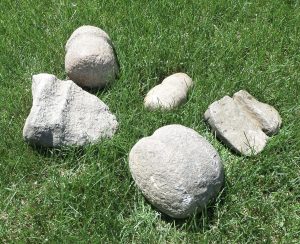
from the North Dakota farm, found sometime after 1905.
23. from Norm: Thanks for your commentaries on the scaffold as well as your remembrances of growing up in the vicinity or the Fort Totten reservation and/or at least driving through it.
I grew up just a few miles from a reservation in Carlton County occupied by the Native Americans who now operate the successful casino located at I-35 and H-210 west of Carlton and south of Cloquet.
The conventional wisdom when I was growing up as well is that you did not want to have car trouble while driving through the reservation, especially around Sawyer which is on H-210 west of Carlton.
The Native Americans were seen in the same light as were negroes in the south and other parts of the country as well just as you said was the case in the state that you grew up in and where I was stationed for eighteen-months at the Minot AFB until being shipped to Thailand.
To this day, many of the residents of my home town and the surrounding area especially those near the ditch-bank areas northeast of town, continue to hold the Native Americans responsible for the lack of deer in the area because “they can hunt at anytime regardless of the season” and so on. They also hold them responsible for any thefts or damage that occurs to property and residences just outside of the reservation.
I had the good fortune to work with many dedicated Native Americans when I was the chief of EMS for the Minnesota Department of Health for several years. We utilized several talented folks from the Red Lake reservation and others as part of our testing crews as well as for the ambulance transportation services in the Red Lake area and on the White Earth reservation as well…and other places beyond that .
It was a privilege to work with them just as it was to work with all number of committed volunteers all across the state who provided basic emergency medical response services to their communities.
The fact that an Native American couple did come off of the reservation to a home just northeast of Cromwell a few years ago and kill a young couple and then stole their new truck that they later tried to burn on the reservation did add fuel to the fire of that perception no matter that the couple was later tried, found guilty and placed in prison.
Thanks again, Dick.
23A. Response from Dick: Thank you. Re your last paragraph “The fact…in prison”, I always pay attention to how such incidents are treated if by “people like us” versus “other”. A dramatic pre-9-11-01 example was Oklahoma City, where initially the suspect was somebody who apparently looked middle eastern. When it became known that it was two white anti-government guys, the conversation seemed to change, immediately.
We have a very long way to go….
(click to enlarge)
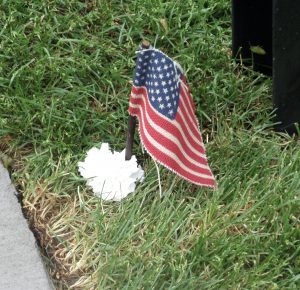
June 11, 2017, about 11 a.m. at southwest corner of the space formerly occupied by the Scaffold.
24. Dick Bernard: I returned to the site again this morning (June 11). A quick storm had passed through, refreshing the space. At the corner of the site of the former Scaffold location, I saw the flag and flower shown above. I don’t know who put it there, what their intention was, how long it will remain…. It was definitely put there on purpose, as would such symbols be seen at the Vietnam Wall in D.C. or elsewhere.
I want to comment briefly on my forbears role in this story, which I hope will continue long after “the ink dries” on these words.
Shortly after Whitestone Hill (1863), the final Treaty transferring Indian Lands to the United States was concluded at Huot Crossing in northwest Minnesota, at the Red Lake River (Huot Old Crossing 1863003). It was to the Treaty land that my French-Canadian ancestors came in 1878, and a number still remain to this day. They settled in Dakota Territory, not far west of the Red River. North Dakota became a state in 1889.
In 1904, my German ancestors came to North Dakota, taking virgin prairie south of Jamestown, perhaps 35 miles from Whitestone Hill, which with hardly any doubt they had never heard about. Whitestone had occurred over 40 years earlier – like the late 1970s compares to today. Indeed, they came across Indian artifacts such as the hammerheads shown above. These were turned over in plowing the prairie. Their farmstead was about three miles from the important James River, and on a rise in the surrounding countryside. Most likely it was a good vantage point in native days, as it is, still.
I doubt that either group, nor any of the ordinary settlers, had any notion of having stolen someone elses land. But, maybe they did?
What we’re left with is the present, over 150 years and many generations after the fact.
It has occurred to me that an appropriate resolution at the Sculpture Garden might be to have a mutually agreed to and designed nature garden (common on the Sculpture Garden grounds) placed at the exact site where the scaffold stood for those few days. That is just a suggestion.
Leaving the garden this morning I decided to take a closer look at what I called the “Chime Tree” yesterday. I was most intrigued by the story accompanying it. Both are pictured below.
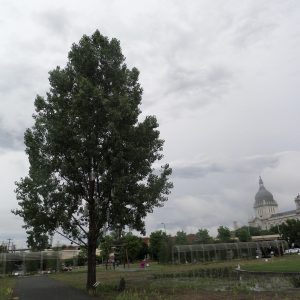
The Cottonwood at the Sculpture Garden, June 11, 2017
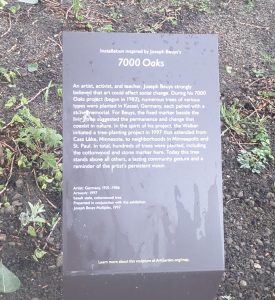
Explanation of the history of the Cottonwood Tree
I wasn’t sure what kind of tree it was, yesterday, but when I saw the word “Cottonwood”, I thought of a story I had written some years ago about another Cottonwood on the North Dakota farm. Here it is.
Let us keep working towards reconciliation, no matter how long or hard the road.
25. from Mary Ellen: I read everything. So much to process. So many important perspectives. I was stunned by the choice of memorial placed where the scaffold stood so briefly– an American flag and a white carnation. What does that mean?
Yes, keep this going!
Right now I have nothing to add. Still thinking.
25A. from Dick, June 18: I was over to the Sculpture Garden today. The flag and white carnation were no longer there. A mystery perhaps no one else will notice or care about. For me, the Sculpture Garden has taken on greater significance than it ever had before.
